Abstract
The distribution of HLA-D region antigens was studied in three groups (I, IIa, and IIb) of patients with rheumatoid arthritis (RA): group I comprised 43 patients with mild, non-progressive RA, controlled by non-steroidal anti-inflammatory drugs without progression or erosions; group II comprised 94 patients with severe disease, who had earlier been treated with non-steroidal anti-inflammatory drugs and all had incomplete response requiring treatment with gold (sodium aurothiomalate). Of these, 46 patients (group IIa) responded to gold and the disease was well controlled, and the remaining 48 patients (group IIb) did not respond to gold and developed gold induced toxic reactions, including thrombocytopenia or proteinuria, or both. HLA-D region antigens were defined by serological and molecular (Southern blot analysis and oligonucleotide typing) techniques. The results show that DR4 was significantly increased in all three groups of patients. The prevalence of DR1, or DR1 in DR4 negative patients, and DR3 and DR4 associated DQw7 specificities, however, showed differences in these three groups of patients. The prevalence of DR1 and of DR1 in DR4 negative patients was increased only in patients with mild (group I) RA, but not in patients with severe (groups IIa and IIb) disease. On the other hand, the prevalence of DR4 associated DQw7 was significantly increased in patients with severe disease, but not in patients with mild RA. In addition, DR3 was significantly increased only in patients with severe disease who developed gold induced toxic reactions (group IIb). These data suggest that the HLA-D region genes which cause susceptibility to mild RA may be different from those causing susceptibility to severe RA. The results suggest that both DR and DQ (A, B) genes may be important in conferring susceptibility to RA: DR in mild disease and DQ in severe RA.
Full text
PDF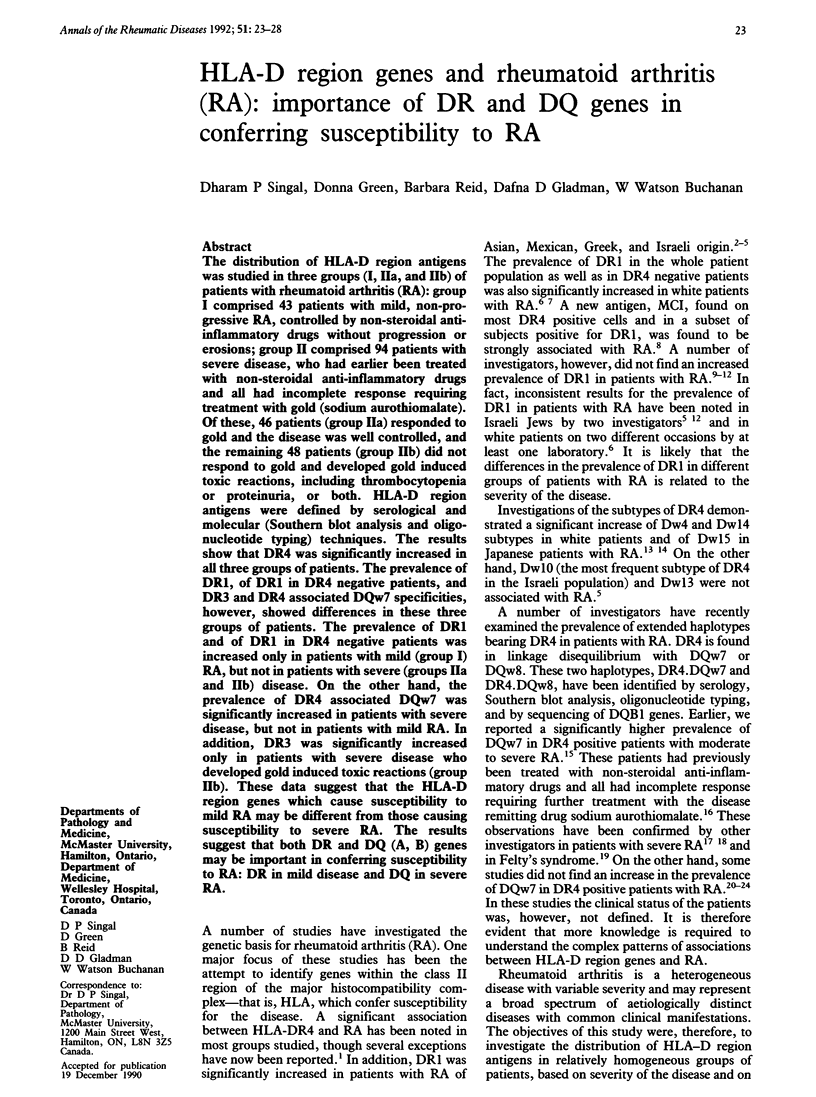
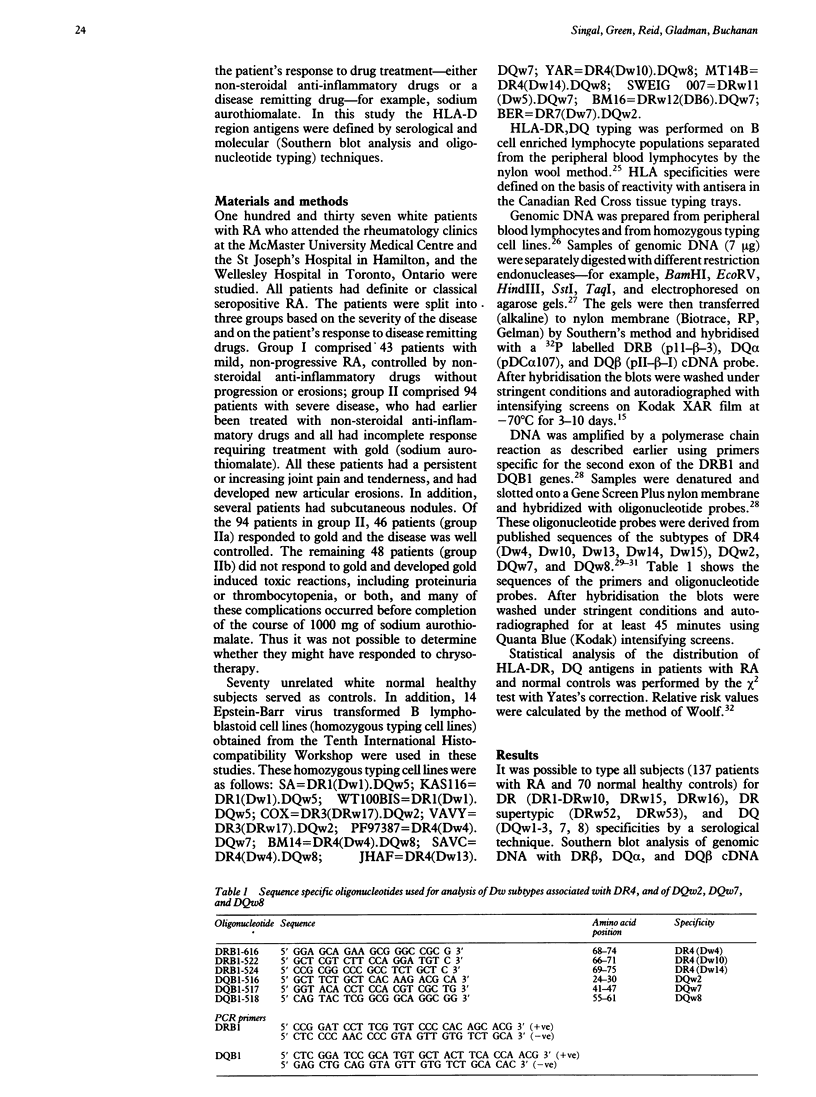
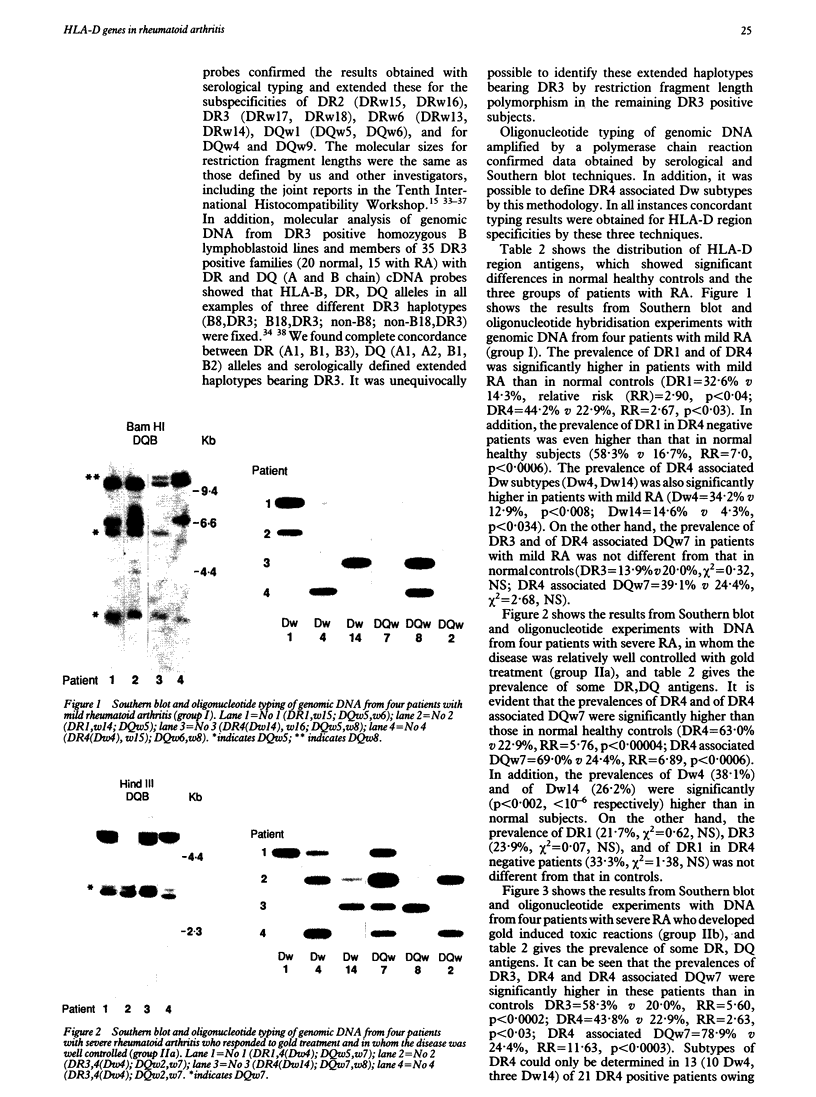
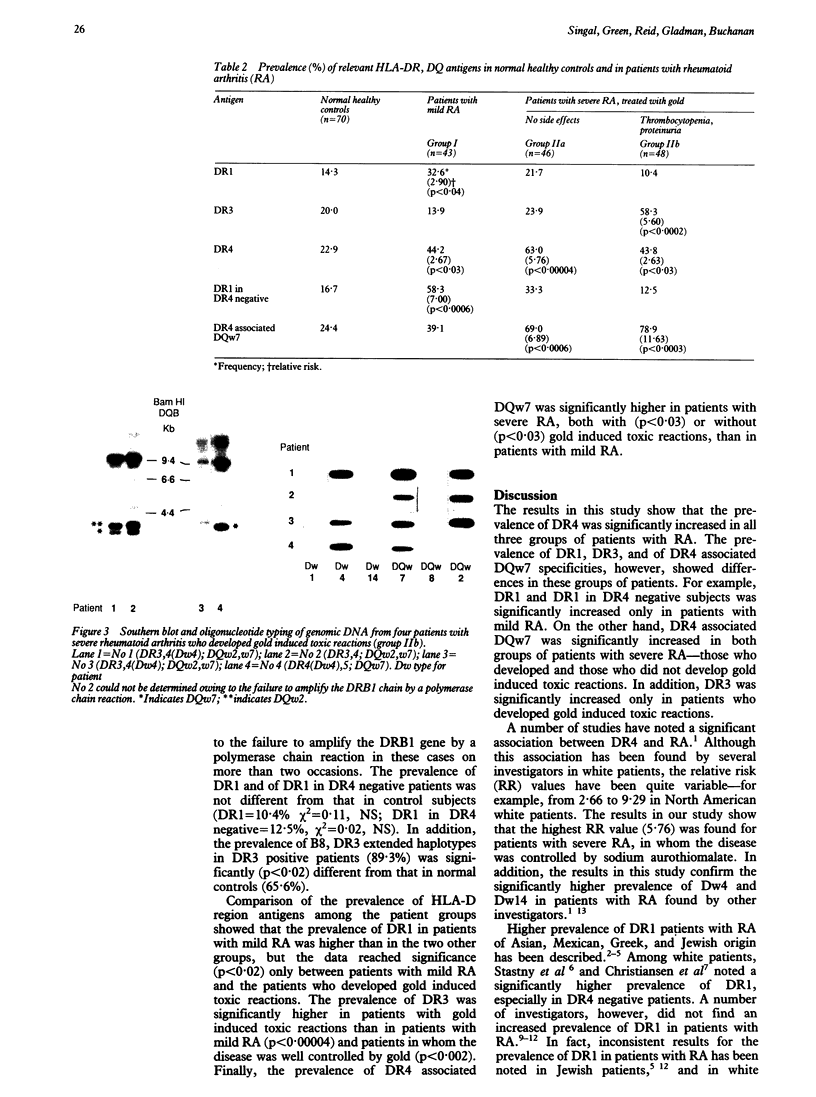
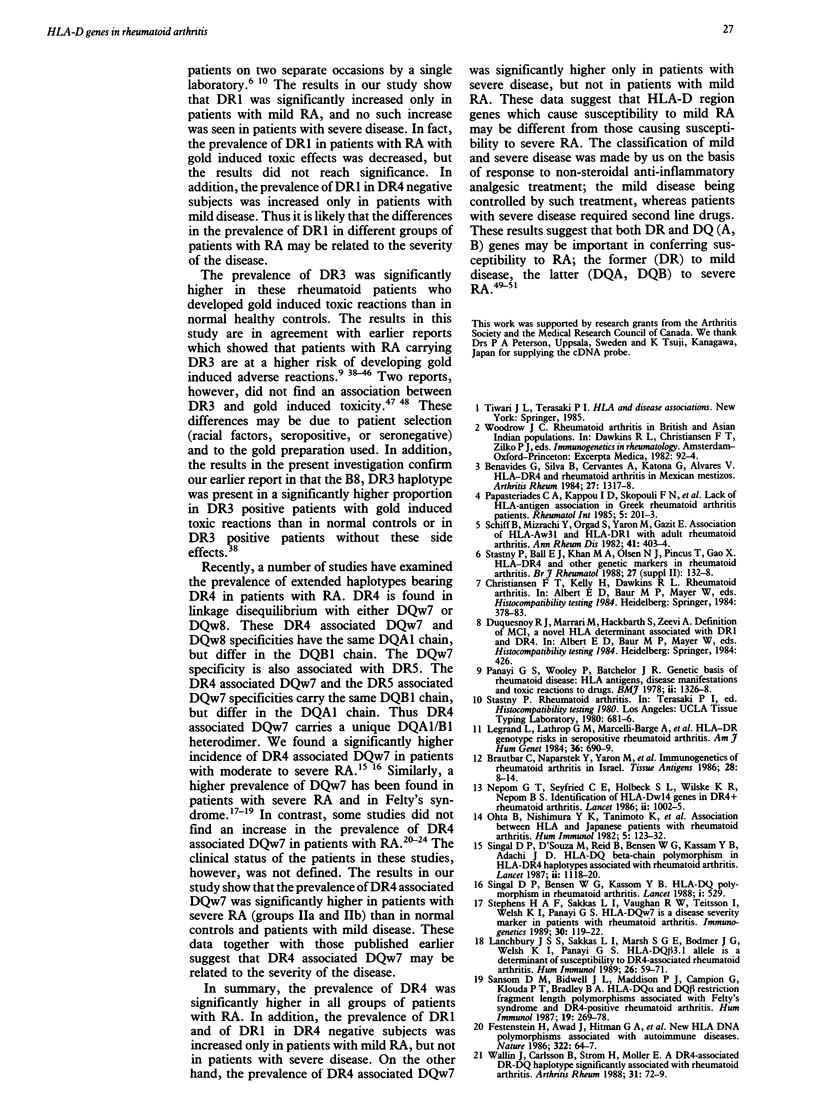
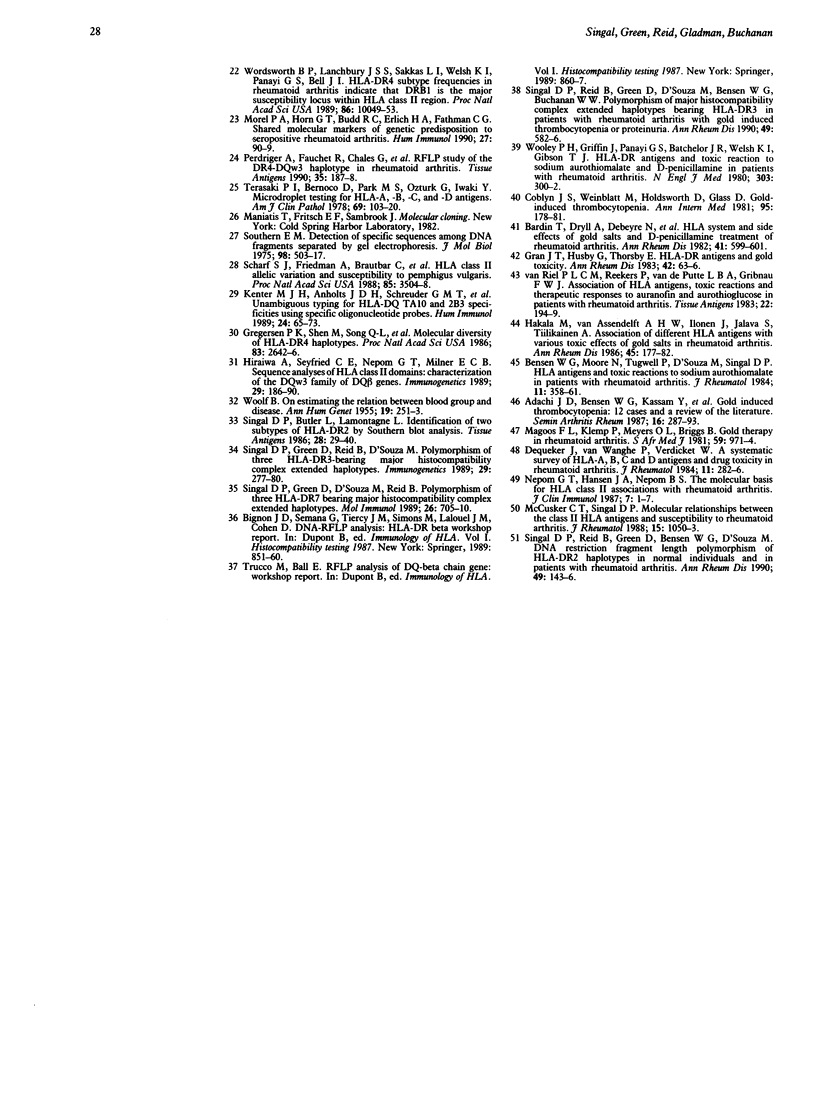
Images in this article
Selected References
These references are in PubMed. This may not be the complete list of references from this article.
- Adachi J. D., Bensen W. G., Kassam Y., Powers P. J., Bianchi F. A., Cividino A., Kean W. F., Rooney P. J., Craig G. L., Buchanan W. W. Gold induced thrombocytopenia: 12 cases and a review of the literature. Semin Arthritis Rheum. 1987 May;16(4):287–293. doi: 10.1016/0049-0172(87)90006-0. [DOI] [PubMed] [Google Scholar]
- Bardin T., Dryll A., Debeyre N., Ryckewaert A., Legrand L., Marcelli A., Dausset J. HLA system and side effects of gold salts and D-penicillamine treatment of rheumatoid arthritis. Ann Rheum Dis. 1982 Dec;41(6):599–601. doi: 10.1136/ard.41.6.599. [DOI] [PMC free article] [PubMed] [Google Scholar]
- Benavides G., Silva B., Cervantes A., Katona G., Alvares V. HLA-DR4 and rheumatoid arthritis in Mexican mestizos. Arthritis Rheum. 1984 Nov;27(11):1317–1318. doi: 10.1002/art.1780271122. [DOI] [PubMed] [Google Scholar]
- Brautbar C., Naparstek Y., Yaron M., Amar A., Ehrenfeld M., Eliakim M., Bentwich Z., Cohen T., Korman S. H., Albert E. D. Immunogenetics of rheumatoid arthritis in Israel. Tissue Antigens. 1986 Jul;28(1):8–14. doi: 10.1111/j.1399-0039.1986.tb00454.x. [DOI] [PubMed] [Google Scholar]
- Coblyn J. S., Weinblatt M., Holdsworth D., Glass D. Gold-induced thrombocytopenia. A clinical and immunogenetic study of twenty-three patients. Ann Intern Med. 1981 Aug;95(2):178–181. doi: 10.7326/0003-4819-95-2-178. [DOI] [PubMed] [Google Scholar]
- Dequeker J., Van Wanghe P., Verdickt W. A systematic survey of HLA-A,B,C and D antigens and drug toxicity in rheumatoid arthritis. J Rheumatol. 1984 Jun;11(3):282–286. [PubMed] [Google Scholar]
- Gran J. T., Husby G., Thorsby E. HLA DR antigens and gold toxicity. Ann Rheum Dis. 1983 Feb;42(1):63–66. doi: 10.1136/ard.42.1.63. [DOI] [PMC free article] [PubMed] [Google Scholar]
- Gregersen P. K., Shen M., Song Q. L., Merryman P., Degar S., Seki T., Maccari J., Goldberg D., Murphy H., Schwenzer J. Molecular diversity of HLA-DR4 haplotypes. Proc Natl Acad Sci U S A. 1986 Apr;83(8):2642–2646. doi: 10.1073/pnas.83.8.2642. [DOI] [PMC free article] [PubMed] [Google Scholar]
- Hakala M., van Assendelft A. H., Ilonen J., Jalava S., Tiilikainen A. Association of different HLA antigens with various toxic effects of gold salts in rheumatoid arthritis. Ann Rheum Dis. 1986 Mar;45(3):177–182. doi: 10.1136/ard.45.3.177. [DOI] [PMC free article] [PubMed] [Google Scholar]
- Hiraiwa A., Seyfried C. E., Nepom G. T., Milner E. C. Sequence analysis of HLA class II domains: characterization of the DQw3 family of DQB genes. Immunogenetics. 1989;29(3):186–190. doi: 10.1007/BF00373644. [DOI] [PubMed] [Google Scholar]
- Kenter M. J., Anholts J. D., Schreuder G. M., van Eggermond M. C., Ghyselen G. M., van Rood J. J., Giphart M. J. Unambiguous typing for HLA-DQ TA10 and 2B3 specificities using specific oligonucleotide probes. Hum Immunol. 1989 Jan;24(1):65–73. doi: 10.1016/0198-8859(89)90047-5. [DOI] [PubMed] [Google Scholar]
- Lanchbury J. S., Sakkas L. I., Marsh S. G., Bodmer J. G., Welsh K. I., Panayi G. S. HLA-DQ beta 3.1 allele is a determinant of susceptibility to DR4-associated rheumatoid arthritis. Hum Immunol. 1989 Sep;26(1):59–71. doi: 10.1016/0198-8859(89)90033-5. [DOI] [PubMed] [Google Scholar]
- Legrand L., Lathrop G. M., Marcelli-Barge A., Dryll A., Bardin T., Debeyre N., Poirier J. C., Schmid M., Ryckewaert A., Dausset J. HLA-DR genotype risks in seropositive rheumatoid arthritis. Am J Hum Genet. 1984 May;36(3):690–699. [PMC free article] [PubMed] [Google Scholar]
- Majoos F. L., Klemp P., Meyers O. L., Briggs B. Gold therapy in rheumatoid arthritis. S Afr Med J. 1981 Jun 27;59(27):971–974. [PubMed] [Google Scholar]
- McCusker C. T., Singal D. P. Molecular relationships between the class II HLA antigens and susceptibility to rheumatoid arthritis. J Rheumatol. 1988 Jul;15(7):1050–1053. [PubMed] [Google Scholar]
- Morel P. A., Horn G. T., Budd R. C., Erlich H. A., Fathman C. G. Shared molecular markers of genetic predisposition to seropositive rheumatoid arthritis. Hum Immunol. 1990 Feb;27(2):90–99. doi: 10.1016/0198-8859(90)90106-y. [DOI] [PubMed] [Google Scholar]
- Nepom G. T., Hansen J. A., Nepom B. S. The molecular basis for HLA class II associations with rheumatoid arthritis. J Clin Immunol. 1987 Jan;7(1):1–7. doi: 10.1007/BF00915418. [DOI] [PubMed] [Google Scholar]
- Nepom G. T., Seyfried C. E., Holbeck S. L., Wilske K. R., Nepom B. S. Identification of HLA-Dw14 genes in DR4+ rheumatoid arthritis. Lancet. 1986 Nov 1;2(8514):1002–1005. doi: 10.1016/s0140-6736(86)92614-0. [DOI] [PubMed] [Google Scholar]
- Ohta N., Nishimura Y. K., Tanimoto K., Horiuchi Y., Abe C., Shiokawa Y., Abe T., Katagiri M., Yoshiki T., Sasazuki T. Association between HLA and Japanese patients with rheumatoid arthritis. Hum Immunol. 1982 Oct;5(2):123–132. doi: 10.1016/0198-8859(82)90057-x. [DOI] [PubMed] [Google Scholar]
- Panayi G. S., Wooley P., Batchelor J. R. Genetic basis of rheumatoid disease: HLA antigens, disease manifestations, and toxic reactions to drugs. Br Med J. 1978 Nov 11;2(6148):1326–1328. doi: 10.1136/bmj.2.6148.1326. [DOI] [PMC free article] [PubMed] [Google Scholar]
- Papasteriades C. A., Kappou I. D., Skopouli F. N., Barla M. N., Fostiropoulos G. A., Moutsopoulos H. M. Lack of HLA-antigen association in Greek rheumatoid arthritis patients. Rheumatol Int. 1985;5(5):201–203. doi: 10.1007/BF00541336. [DOI] [PubMed] [Google Scholar]
- Perdriger A., Fauchet R., Chales G., Semana G., Quillivic F., Lore P., Meadeb J., Pawlotsky Y. RFLP study of the DR4-DQw3 haplotype in rheumatoid arthritis. Tissue Antigens. 1990 Apr;35(4):187–188. doi: 10.1111/j.1399-0039.1990.tb01778.x. [DOI] [PubMed] [Google Scholar]
- Sansom D. M., Bidwell J. L., Maddison P. J., Campion G., Klouda P. T., Bradley B. A. HLA DQ alpha and DQ beta restriction fragment length polymorphisms associated with Felty's syndrome and DR4-positive rheumatoid arthritis. Hum Immunol. 1987 Aug;19(4):269–278. doi: 10.1016/0198-8859(87)90044-9. [DOI] [PubMed] [Google Scholar]
- Sansom D. M., Bidwell J. L., Maddison P. J., Campion G., Klouda P. T., Bradley B. A. HLA DQ alpha and DQ beta restriction fragment length polymorphisms associated with Felty's syndrome and DR4-positive rheumatoid arthritis. Hum Immunol. 1987 Aug;19(4):269–278. doi: 10.1016/0198-8859(87)90044-9. [DOI] [PubMed] [Google Scholar]
- Scharf S. J., Friedmann A., Brautbar C., Szafer F., Steinman L., Horn G., Gyllensten U., Erlich H. A. HLA class II allelic variation and susceptibility to pemphigus vulgaris. Proc Natl Acad Sci U S A. 1988 May;85(10):3504–3508. doi: 10.1073/pnas.85.10.3504. [DOI] [PMC free article] [PubMed] [Google Scholar]
- Schiff B., Mizrachi Y., Orgad S., Yaron M., Gazit E. Association of HLA-Aw31 and HLA-DR1 with adult rheumatoid arthritis. Ann Rheum Dis. 1982 Aug;41(4):403–404. doi: 10.1136/ard.41.4.403. [DOI] [PMC free article] [PubMed] [Google Scholar]
- Singal D. P., Bensen W. G., Kassam Y. B. HLA-DQ polymorphism in rheumatoid arthritis. Lancet. 1988 Mar 5;1(8584):529–529. doi: 10.1016/s0140-6736(88)91315-3. [DOI] [PubMed] [Google Scholar]
- Singal D. P., Butler L., Lamontagne L. Identification of two subtypes of HLA-DR2 by Southern blot analysis. Tissue Antigens. 1986 Jul;28(1):29–40. doi: 10.1111/j.1399-0039.1986.tb00457.x. [DOI] [PubMed] [Google Scholar]
- Singal D. P., D'Souza M., Reid B., Bensen W. G., Kassam Y. B., Adachi J. D. HLA-DQ beta-chain polymorphism in HLA-DR4 haplotypes associated with rheumatoid arthritis. Lancet. 1987 Nov 14;2(8568):1118–1120. doi: 10.1016/s0140-6736(87)91548-0. [DOI] [PubMed] [Google Scholar]
- Singal D. P., Green D., D'Souza M., Reid B. Polymorphism of three HLA-DR7 bearing major histocompatibility complex extended haplotypes. Mol Immunol. 1989 Aug;26(8):705–710. doi: 10.1016/0161-5890(89)90029-1. [DOI] [PubMed] [Google Scholar]
- Singal D. P., Green D., Reid B., D'Souza M. Polymorphism of three HLA-DR3-bearing major histocompatibility complex extended haplotypes. Immunogenetics. 1989;29(4):277–280. doi: 10.1007/BF00717914. [DOI] [PubMed] [Google Scholar]
- Singal D. P., Reid B., Green D., Bensen W. G., D'Souza M. DNA restriction fragment length polymorphism of HLA-DR2 haplotypes in normal individuals and in patients with rheumatoid arthritis. Ann Rheum Dis. 1990 Mar;49(3):143–146. doi: 10.1136/ard.49.3.143. [DOI] [PMC free article] [PubMed] [Google Scholar]
- Singal D. P., Reid B., Green D., D'Souza M., Bensen W. G., Buchanan W. W. Polymorphism of major histocompatibility complex extended haplotypes bearing HLA-DR3 in patients with rheumatoid arthritis with gold induced thrombocytopenia or proteinuria. Ann Rheum Dis. 1990 Aug;49(8):582–586. doi: 10.1136/ard.49.8.582. [DOI] [PMC free article] [PubMed] [Google Scholar]
- Southern E. M. Detection of specific sequences among DNA fragments separated by gel electrophoresis. J Mol Biol. 1975 Nov 5;98(3):503–517. doi: 10.1016/s0022-2836(75)80083-0. [DOI] [PubMed] [Google Scholar]
- Stastny P., Ball E. J., Khan M. A., Olsen N. J., Pincus T., Gao X. HLA-DR4 and other genetic markers in rheumatoid arthritis. Br J Rheumatol. 1988;27 (Suppl 2):132–138. doi: 10.1093/rheumatology/xxvii.suppl_2.132. [DOI] [PubMed] [Google Scholar]
- Stephens H. A., Sakkas L. I., Vaughan R. W., Teitsson I., Welsh K. I., Panayi G. S. HLA-DQw7 is a disease severity marker in patients with rheumatoid arthritis. Immunogenetics. 1989;30(2):119–122. doi: 10.1007/BF02421540. [DOI] [PubMed] [Google Scholar]
- Stephens H. A., Sakkas L. I., Vaughan R. W., Teitsson I., Welsh K. I., Panayi G. S. HLA-DQw7 is a disease severity marker in patients with rheumatoid arthritis. Immunogenetics. 1989;30(2):119–122. doi: 10.1007/BF02421540. [DOI] [PubMed] [Google Scholar]
- Terasaki P. I., Bernoco D., Park M. S., Ozturk G., Iwaki Y. Microdroplet testing for HLA-A, -B, -C, and -D antigens. The Phillip Levine Award Lecture. Am J Clin Pathol. 1978 Feb;69(2):103–120. doi: 10.1093/ajcp/69.2.103. [DOI] [PubMed] [Google Scholar]
- WOOLF B. On estimating the relation between blood group and disease. Ann Hum Genet. 1955 Jun;19(4):251–253. doi: 10.1111/j.1469-1809.1955.tb01348.x. [DOI] [PubMed] [Google Scholar]
- Wallin J., Carlsson B., Ström H., Möller E. A DR4-associated DR-DQ haplotype is significantly associated with rheumatoid arthritis. Arthritis Rheum. 1988 Jan;31(1):72–79. doi: 10.1002/art.1780310111. [DOI] [PubMed] [Google Scholar]
- Wooley P. H., Griffin J., Panayi G. S., Batchelor J. R., Welsh K. I., Gibson T. J. HLA-DR antigens and toxic reaction to sodium aurothiomalate and D-penicillamine in patients with rheumatoid arthritis. N Engl J Med. 1980 Aug 7;303(6):300–302. doi: 10.1056/NEJM198008073030602. [DOI] [PubMed] [Google Scholar]
- Wordsworth B. P., Lanchbury J. S., Sakkas L. I., Welsh K. I., Panayi G. S., Bell J. I. HLA-DR4 subtype frequencies in rheumatoid arthritis indicate that DRB1 is the major susceptibility locus within the HLA class II region. Proc Natl Acad Sci U S A. 1989 Dec;86(24):10049–10053. doi: 10.1073/pnas.86.24.10049. [DOI] [PMC free article] [PubMed] [Google Scholar]
- van Riel P. L., Reekers P., van de Putte L. B., Gribnau F. W. Association of HLA antigens, toxic reactions and therapeutic response to auranofin and aurothioglucose in patients with rheumatoid arthritis. Tissue Antigens. 1983 Sep;22(3):194–199. doi: 10.1111/j.1399-0039.1983.tb01191.x. [DOI] [PubMed] [Google Scholar]





